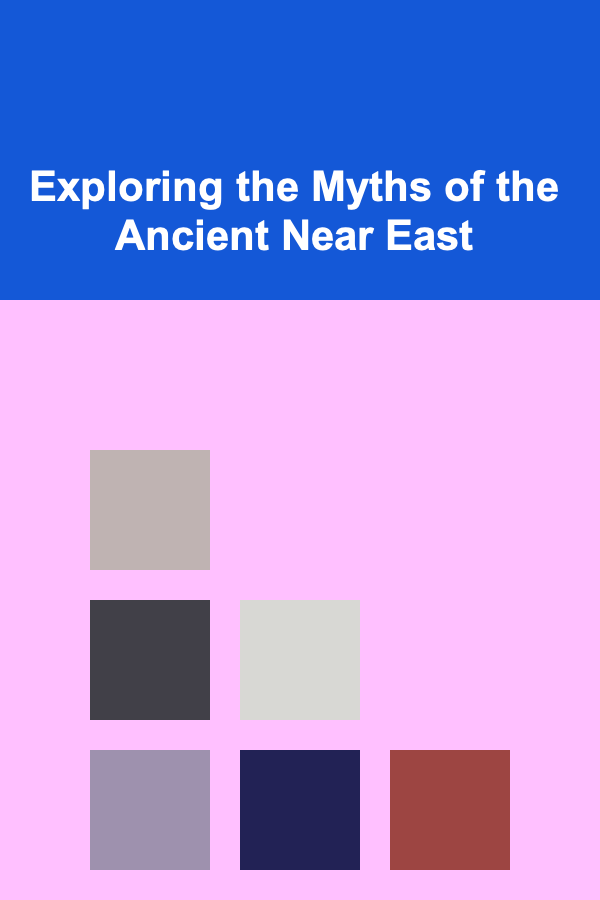
Exploring the Myths of the Ancient Near East
ebook include PDF & Audio bundle (Micro Guide)
$12.99$10.99
Limited Time Offer! Order within the next:

The Ancient Near East, a cradle of civilization encompassing Mesopotamia, Egypt, the Levant, and Anatolia, bequeathed to humanity not only groundbreaking advancements in agriculture, writing, and law but also a rich tapestry of myths. These narratives, woven from the threads of human experience and the natural world, offer invaluable insights into the beliefs, values, and worldview of these ancient societies. Exploring these myths is not merely an academic exercise; it is a journey into the collective psyche of the people who shaped the foundations of Western culture and beyond.
Deciphering the Context: A Multifaceted Approach
Before delving into the intricacies of specific myths, it's crucial to establish a solid foundation for interpretation. This requires a multifaceted approach, encompassing linguistic, historical, archaeological, and comparative perspectives.
The Primacy of Linguistic Mastery
The first and arguably most important step is to access the myths in their original languages. Texts like the Epic of Gilgamesh, the Enuma Elish, and the Egyptian Book of the Dead were initially written in Akkadian, Sumerian, Egyptian hieroglyphs (and later hieratic and demotic), and related languages. While translations offer accessibility, they inevitably introduce interpretive biases and potentially obscure nuances present in the original. Studying these languages, or consulting scholarly analyses based on the original texts, is paramount for a truly nuanced understanding. This includes not only understanding the grammar and vocabulary but also recognizing the literary devices and rhetorical strategies employed by the original authors. For instance, understanding the use of parallelism in Hebrew poetry is essential for interpreting biblical narratives.
Historical Context: Situating Myths in Time
Myths are not created in a vacuum. They are products of their specific historical context. Understanding the political, social, economic, and religious conditions prevailing at the time of their creation and transmission is critical. For example, the rise of Marduk in the Babylonian pantheon, as depicted in the Enuma Elish, is inextricably linked to the political ascendancy of Babylon during the Old Babylonian period. Similarly, the emphasis on maat (cosmic order) in Egyptian mythology reflects the importance of stability and centralized authority in pharaonic society. Examining archaeological findings, historical records, and contemporary sources can shed light on the socio-political forces shaping the myths.
Archaeological Evidence: Materializing the Myths
Archaeology provides tangible evidence that complements and enriches our understanding of ancient Near Eastern myths. The discovery of monumental temples dedicated to deities, elaborate burial rituals, and depictions of mythological scenes on pottery, cylinder seals, and wall reliefs offer valuable insights into the material culture associated with these narratives. For instance, the discovery of ziggurats in Mesopotamia corroborates the accounts of towering structures found in myths like the Tower of Babel. Similarly, the discovery of elaborate tombs filled with funerary offerings in Egypt confirms the importance of the afterlife and the elaborate rituals described in the Book of the Dead.
Comparative Mythology: Unveiling Universal Themes
While each myth is unique to its cultural context, comparing myths across different cultures can reveal recurring themes, motifs, and archetypes. This approach, known as comparative mythology, helps identify universal human concerns and patterns of storytelling. For example, the flood myth, a recurring motif in Mesopotamian, biblical, and Greek mythology, reflects a common human anxiety about catastrophic events and the potential for renewal. Similarly, the hero's journey, a narrative structure identified by Joseph Campbell, can be found in myths from various cultures, including the Epic of Gilgamesh and the story of Theseus. However, it is crucial to avoid imposing a singular framework onto diverse mythologies. The goal is to identify similarities and differences, not to reduce all myths to a common denominator.
Key Mythological Themes in the Ancient Near East
The myths of the Ancient Near East cover a broad range of themes, reflecting the diverse concerns and experiences of the people who created them. Some of the most prominent themes include:
Cosmogony and Creation Myths
These myths explain the origins of the universe, the earth, and humanity. They often involve a primordial chaos or a struggle between divine forces. The Enuma Elish, the Babylonian creation epic, describes how Marduk, the patron deity of Babylon, defeated the primordial sea goddess Tiamat and created the world from her dismembered body. In Egyptian mythology, the sun god Ra emerges from the primordial waters of Nun and creates the world through his own power. These creation myths not only explain the origins of the cosmos but also establish the relationship between gods and humans, and the hierarchical order of the universe.
The Pantheon and Divine Hierarchy
The Ancient Near Eastern societies were polytheistic, with pantheons of gods and goddesses who controlled various aspects of the natural world and human life. Each deity had specific attributes, roles, and responsibilities. In Mesopotamia, the pantheon was typically headed by Anu (the sky god), Enlil (the storm god), and Enki (the god of wisdom and water). In Egypt, the pantheon included Ra (the sun god), Osiris (the god of the afterlife), Isis (the goddess of magic and motherhood), and Horus (the falcon-headed god). Understanding the relationships between these deities, their individual characteristics, and the rituals associated with their worship is essential for interpreting the myths in which they appear.
Humanity and the Divine
Myths often explore the relationship between humans and the divine, including the creation of humanity, the nature of mortality, and the possibility of divine favor or punishment. In the Mesopotamian myth of Atrahasis, humanity is created to perform labor for the gods, but their overpopulation leads to divine intervention in the form of floods and plagues. In Egyptian mythology, the pharaoh was considered a divine ruler, a link between the earthly and divine realms. Myths also often explain the origin of rituals and religious practices, serving as a justification for the established order.
The Afterlife and Mortuary Rituals
Beliefs about the afterlife played a significant role in the religious practices of the Ancient Near East. Myths often depict the journey of the soul after death, the challenges faced in the underworld, and the possibility of eternal life or resurrection. The Egyptian Book of the Dead provides detailed instructions for navigating the afterlife, including spells and incantations to overcome obstacles and ensure a favorable judgment by Osiris. Mesopotamian beliefs about the afterlife were generally more pessimistic, portraying the underworld as a bleak and desolate place. Understanding these beliefs is crucial for interpreting the elaborate mortuary rituals and the significance of funerary offerings found in archaeological excavations.
Heroes and Monsters
Myths often feature heroic figures who embody cultural ideals and face extraordinary challenges. The Epic of Gilgamesh, for example, tells the story of a legendary king of Uruk who embarks on a quest for immortality, confronting monsters and facing the limitations of human existence. Theseus, a hero from Greek mythology (influenced by Near Eastern traditions), is famed for his defeat of the Minotaur. Monsters often represent chaos, disorder, and the dangers that threaten human society. The battles between heroes and monsters symbolize the ongoing struggle between order and chaos, and the triumph of good over evil.
Case Studies: Delving into Specific Myths
To illustrate the principles of exploration, let's examine a few specific myths from the Ancient Near East:
The Epic of Gilgamesh (Mesopotamia)
The Epic of Gilgamesh, one of the oldest known works of literature, tells the story of Gilgamesh, the king of Uruk, and his quest for immortality. Initially depicted as a tyrannical ruler, Gilgamesh's friendship with Enkidu, a wild man tamed by civilization, transforms him. They embark on a series of heroic adventures, slaying the monster Humbaba and defying the goddess Ishtar. After Enkidu's death, Gilgamesh is consumed by grief and fear of mortality, leading him on a perilous journey to seek the secret of eternal life from Utnapishtim, the survivor of the Great Flood. The epic explores themes of friendship, mortality, the limitations of human power, and the importance of accepting one's fate. Analyzing the Akkadian text reveals subtle nuances in the characterization of Gilgamesh and the other figures, providing a richer understanding of the epic's complex themes. The epic's influence can be seen in later literary works, including the biblical story of Noah's Ark and the Greek myths of heroes like Heracles. Archaeological evidence, such as depictions of Gilgamesh on cylinder seals and the discovery of fragments of the epic at various sites, corroborates the story's historical and cultural significance.
The Enuma Elish (Babylonia)
The Enuma Elish, the Babylonian creation epic, describes the origin of the universe and the rise of Marduk, the patron deity of Babylon. In the beginning, there was only primordial chaos, represented by the waters of Apsu and Tiamat. The younger gods, created by Apsu and Tiamat, disturb the peace with their noisy activities, prompting Apsu to plot their destruction. Tiamat, initially sympathetic to her children, is enraged by Apsu's death and raises an army of monsters to avenge him. Marduk, a young and powerful god, volunteers to fight Tiamat, promising to establish order and justice in the universe. He defeats Tiamat, splitting her body in two to create the sky and the earth. He then creates humanity to serve the gods and establishes Babylon as the center of the world. The Enuma Elish is not just a creation myth; it is also a political statement that legitimizes the dominance of Babylon and its patron deity. Analyzing the text reveals the hierarchical structure of the Babylonian pantheon and the importance of Marduk's role in maintaining cosmic order. The epic was recited during the New Year festival (Akitu) in Babylon, reinforcing the city's political and religious authority. The myth's influence can be seen in later Mesopotamian religious practices and its potential influence on the biblical creation narratives.
The Myth of Osiris (Egypt)
The myth of Osiris is central to Egyptian beliefs about the afterlife, resurrection, and the cycle of life and death. Osiris, the king of Egypt, is murdered by his jealous brother Seth, who dismembers his body and scatters the pieces throughout the land. Isis, Osiris's wife and sister, searches for the pieces of his body and reassembles them, using her magical powers to revive him. Osiris becomes the ruler of the underworld, judging the souls of the dead and granting them eternal life. Horus, the son of Osiris and Isis, eventually defeats Seth and restores order to Egypt, becoming the new pharaoh. The myth of Osiris embodies the Egyptian belief in the importance of preserving the body after death and the possibility of resurrection through proper rituals and magical spells. The elaborate mortuary practices, including mummification and the construction of elaborate tombs, reflect this belief. The Book of the Dead, a collection of spells and incantations, was placed in tombs to guide the deceased through the afterlife and ensure their successful journey. The myth of Osiris also reinforces the divine authority of the pharaoh, who was seen as the earthly embodiment of Horus and the protector of cosmic order.
Challenges and Caveats
Exploring ancient Near Eastern myths is not without its challenges. Fragmentary texts, linguistic ambiguities, and the lack of direct access to the beliefs and practices of ancient societies can make interpretation difficult. It's crucial to be aware of these limitations and to avoid making overly simplistic or definitive interpretations. Here are some key caveats to consider:
- Fragmentary Evidence: Many of the texts and artifacts we have are incomplete or damaged, making it difficult to reconstruct the original myths in their entirety.
- Interpretive Bias: Our own cultural background and preconceptions can influence our interpretation of ancient myths. It's essential to be aware of our own biases and to strive for objectivity.
- Limited Context: We often lack a complete understanding of the social, political, and religious context in which these myths were created and transmitted.
- Multiple Interpretations: Myths can have multiple layers of meaning and can be interpreted in different ways depending on the perspective of the interpreter.
- The Danger of Essentialism: Avoid reducing complex mythologies to simplistic summaries or generalizations. Each myth is a product of its unique cultural context and should be understood in its own terms.
Conclusion
Exploring the myths of the Ancient Near East is a rewarding but demanding endeavor. By embracing a multifaceted approach that incorporates linguistic mastery, historical context, archaeological evidence, and comparative mythology, we can gain a deeper understanding of the beliefs, values, and worldview of these ancient societies. While challenges and caveats exist, the potential for unlocking the secrets of these ancient narratives makes the journey worthwhile. These myths offer not only a glimpse into the past but also a reflection on the enduring human quest for meaning, purpose, and understanding in the face of the unknown. They remind us that despite the vast differences in time and culture, we share a common human heritage and a common human experience.
Reading More From Our Other Websites
- [Home Storage Solution 101] How to Maximize Small Room Space: Saving Ideas for Better Living
- [Organization Tip 101] How to Conduct a Thorough Inventory Assessment
- [Personal Investment 101] How to Use Pre-Trained Models to Make Money
- [Home Staging 101] How to Stage a Home with a Limited Budget
- [Personal Financial Planning 101] How to Achieve Financial Goals by Setting SMART Objectives
- [Home Lighting 101] How to Install Semi-Flush Mount Lights for a Modern Look
- [Whitewater Rafting Tip 101] From Rapids to Results: The Ultimate Rafting Workout for Full-Body Conditioning
- [Home Rental Property 101] How to Avoid Common Mistakes Landlords Make with Rental Properties
- [Organization Tip 101] How to Choose the Right Self-Leveling Underlayment for Your Floor
- [Organization Tip 101] How to Create a Seasonal Centerpiece That's Easy to Change

How To Create Dramatic Long Exposure Photography
Read More
How to Declutter Your Hobby Room for a Fresh Start
Read More
How to Maintain a Clean Home with a Busy Family
Read More
How To Photograph the Aurora with Long Exposure
Read More
How to Create VR Storyboards
Read More
How to Color Landscapes with Watercolor Pencils
Read MoreOther Products

How To Create Dramatic Long Exposure Photography
Read More
How to Declutter Your Hobby Room for a Fresh Start
Read More
How to Maintain a Clean Home with a Busy Family
Read More
How To Photograph the Aurora with Long Exposure
Read More
How to Create VR Storyboards
Read More